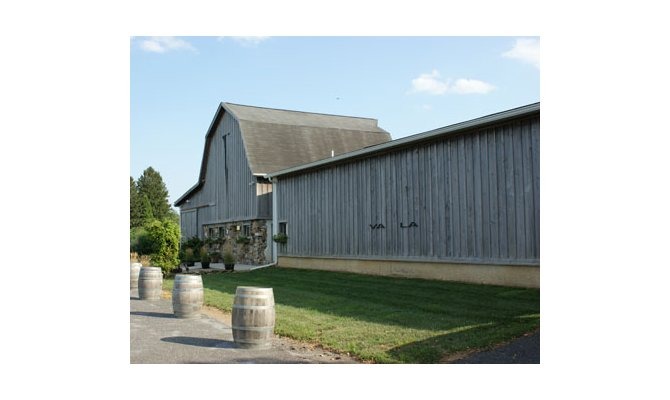Birth Of A Vineyard Slideshow
Anthony Vietri
Anthony Vietri began his career as a Hollywood script writer but decided in the late 1990s to return to his family farm outside of Avondale near the Delaware line to become a winegrower with his wife Karen. His family has been small-parcel farmers since the 1600s, first in Italy but since the 1920s in Pennsylvania, where they have grown a variety of crops, including corn, a grove of chestnuts, a small vineyard of American grapes and, most recently, mushrooms — the major agricultural industry in the region.
The Grapes
Vietri's family, like many Italian immigrants, also purchased grapes transported from California for homemade wines, and Anthony and Karen at first thought about become winemakers on the California coast. But then he took another look at the property where his great-grandparents and great-uncle farmed. "It kind of hit me that the hill drains in all directions, which is good," he says. "Then we brought in back hoes to dig soil pits, and we couldn't reach bedrock." Chemically, the soil was well-balanced and needed only the natural nitrogen produced by grasses in the vineyard rows and vine cuttings.
The Vines
Soil studies showed that the space available for vines — 6.73 acres that Vietri refers to as "the field" — is naturally divided into four different sub-sections, which would eventually become keys to Vietri's master plan. At one time, the East Coast was thought inhospitable to classic European vinifera grapes, but other wineries over the past 50 years have shown that not to be the case, and today the mid-Atlantic region primarily grows the same varieties that are grown in Bordeaux and Burgundy.
The Right Road
Vietri was not so sure he wanted to follow the French road, so he planted his first vineyard in 1999 with about 50 percent in these varieties and the other half in grapes mainly from his family's ancestral home — northern Italy. "Things failed here that worked in other places in the region," he reports. "Cabernet sauvignon was a complete bust," the vines dying of winter kill. Some of the Italian-based grapes, such as barbera and nebbiolo, flourished and made very good wines, while others, such as dolcetto, had too many diseases caused by the humid East Coast climate. Vietri jokes that the heat-producing, odiferous production of mushroom soil next door allows for a dense if temporary fog that nebbiolo loves.
Va La Vineyards
In 2002, the Vietris opened their winery with the hands-on help of their families in a converted barn on the property. They called it Va La Vineyards — the "va la" a play between the Italian phrase that means "go there" or "get out of here" and Giusvalla, the name of the village where much of his mother's family lived before coming to America. "I would set behind the tasting bar, wondering if anyone would ever come through the door," he remembers. "I wondered if anyone would ever pay $20 a bottle for our wines."
Evolution
They did come, and they did purchase the wines, which, according to plans, were mainly blends. Although Vietri originally purchased a few grapes from other growers to get started, he gradually began making all his wines — up to about 750 cases in a good year — from his own grapes. As a friend and neighbor, I have watched this evolution over many shared glasses of wine, as Vietri has literally planted dozens, perhaps even hundreds, of different varieties and clones to see which ones worked best and in which of the four sub-plots. "The goal for the vineyard planting, and the reason for the non-traditional blends, has been to create a blend of varieties that might more deeply express this single place in the spirit of vin de terroir," Vietri says.
Critical Praise
Not only did the customers come, so did the critical praise. And not just from me, but from other critics such as Craig LaBan of the Philadelphia Inquirer and David Schildknecht of Vinaria. Part of the praise is the result of the terroir — where the grapes are grown — but also credit Vietri's vision and tough- love, labor-intensive vineyard practices to control yield and enhance quantity. This has allowed him to charge $25 to $45 a bottle — unheard of in the region — and to sell everything he makes, almost all in the winery's tasting room.
Today's Wines
Today — 14 years after planting the first vines — what Vietri likes to refer to as "our little vineyard" produces four wines:
- "Mahogany," produced by the black mushroom soils of the center area of the hill, from the varieties malvasia nero, barbera, sagrantino, carmine, lagrein, charbono, teroldego and petit verdot.
- "La Prima Donna," produced by the stony soils of the southeast area of the field from the white grapes tocai, malvasia bianca, viognier,pinot grigio, and petit manseng.
- "Silk," a dry rosato produced from the soils of the eastern slopes of the hill from the varietiescorvina veronese, barbera, nebbiolo, carmine, and petit verdot among others.
- "Cedar" produced by the red soils on the western edge of the field from five clones of nebbiolo lampia & michet and corvina veronese.








